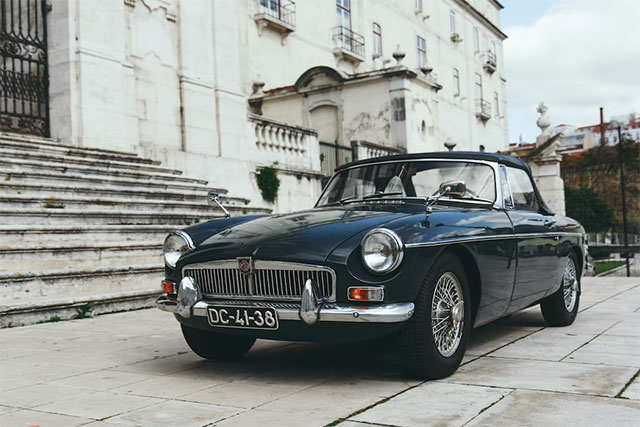Owning a classic car usually feels joyous, especially when you’re passionate about your vehicle. However, it also comes with extra responsibilities. Keeping a classic car clean isn’t the same as keeping a modern car clean; you need to take an approach that matches your vehicle’s vintage.
Table of Contents
Classic Car Cleaning Tips

Whether you’re new to owning a classic car or you need an information refresh, try these handy tips:
Avoid Using a Car Wash
The world of car paint jobs has developed significantly since classic cars were released. Today’s paintwork can withstand a lot of pressure. If your vehicle still features its original paint, it’s more prone to damage in certain conditions.
Because of this, washing by hand is the way forward. Car washes apply lots of pressure to paintwork and use high-heat tools to reduce moisture. While modern acrylic lacquers can withstand this, your faithful classic may not.
Instead, focus on using soft microfibre cloths for the paint and gentle bristle brushes for metal work. Try cleaning your car on a warm day without too much sun for an enticing finish. Cars that dry too quickly in the sun may be prone to streaking, which can undo your efforts.
Alternatively, wipe the car down with a soft dry towel.
Always ensure you use the two-bucket method too. Have one bucket for your cleaning fluid and another for clear water. Use the second bucket to rinse your sponge regularly. Doing so avoids spreading dirt from place to place.
Use Appropriate Cleaning Fluids
Using proper cleaning fluids on your classic car isn’t just an aesthetic matter; it’s a safety one. Some everyday fluids may be too abrasive for the paintwork. Additionally, there are areas of your classic car where large amounts of water aren’t suitable.
As well as cleaning the car’s exterior, it would help if you tackled the engine bay. If yours is covered in dirt and grime, it may not be operating at peak efficiency. An overly dirty or inefficient engine may nullify your classic car insurance too.
When cleaning your car’s engine bay, don’t assume it can handle lots of water. Most of it is water-resistant, but you must avoid soaking electrical areas. Again, this can nullify your insurance.
Instead, use a cleaning wax appropriate for your car’s engine bay. It’ll lift dirt away and make everything sparkle without risking its electrical integrity.
Rinse Your Classic Car Regularly
Rinsing your classic car regularly is an excellent way to reduce the times you need to wash it. Whether you drive your car every day or it sits on a driveway, it’s slowly but surely gathering dust. That dust can thicken, resulting in a need for hefty cleaning efforts later.
Thick dust and small amounts of debris may also result in minor abrasions to your paintwork and windscreen. An easy way to resolve this is by rinsing your car regularly with clear water.
Give your car a clear water rinse at least once a week. Stay aware of the weather in your local area too. If you’re living in a sandy or coastal area, periods of high wind may result in more dust blowing onto your car. Following windy periods, rinse your vehicle quickly to eliminate dust buildup.
Focus on UV Protection
The sun’s rays aren’t just harmful to human skin. Too much sunlight can damage your classic car, too. This is especially the case for leather, which will likely fade in patches depending on where the sun falls and how intense the UV rays are.
You have a couple of options when it comes to UV protection. If you don’t keep your car indoors, place it under a protective cover between drives and cleaning sessions. Not only will the cover keep it away from UV rays, but it’ll also reduce some of the dirt that falls onto it.
It will help if you use UV protection creams specific to the material you’re focusing on. For example, leather is a fabric vulnerable to fading beneath the sun’s rays. Using a protective cream at regular intervals can prevent the need for restoration work.
How often you’ll need to use UV protection creams can vary according to where you live. Try using a UV index tool to identify how strong the sunlight is in your area. If the forecast is high where you live, you’ll need more UV protection than in a low-risk area.
Don’t Neglect the Undercarriage
In your attempts to keep your classic car clean, it’s easy to forget about the undercarriage. Although this is an area you don’t look at often, it is prone to rust. A dirty undercarriage is more likely to rust, so it’s worth paying attention to.
To keep your car’s undercarriage clean, you’ll need a jack, pressure washer, and degreasing solution. Ensure you’re familiar with using a jack and ask for help to stay safe.
Try using the degreasing solution first to tackle greasy areas before using the pressure washer. Oil and water don’t mix well, so degreasing in advance gives you a head start. After, use the pressure washer and dry the undercarriage manually using a soft cloth. Depending on the age of your car, you may also need to use a tar removal solution.
Keeping your classic car clean requires a combination of love and effort. In return for the time you put in, you’ll enjoy your vintage vehicle for longer.













